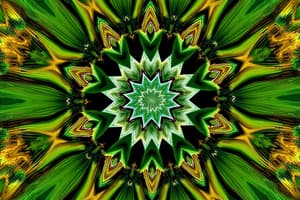Podcast
Questions and Answers
What type of pattern describes the arrangement of petals in flowers?
What type of pattern describes the arrangement of petals in flowers?
- Wave patterns
- Numerical patterns (correct)
- Chaotic patterns
- Geometric patterns
Mathematics can be used to predict the behavior of natural phenomena.
Mathematics can be used to predict the behavior of natural phenomena.
True (A)
What is the primary purpose of mathematics in relation to patterns in nature?
What is the primary purpose of mathematics in relation to patterns in nature?
To organize patterns and regularities in the world.
The Fibonacci sequence is associated with the concept of a __________ rectangle.
The Fibonacci sequence is associated with the concept of a __________ rectangle.
Match the following types of patterns with their examples:
Match the following types of patterns with their examples:
Which of the following is NOT a function that influences plant growth?
Which of the following is NOT a function that influences plant growth?
Chaos patterns include clouds and river networks.
Chaos patterns include clouds and river networks.
Who is known for studying the patterns in snowflakes?
Who is known for studying the patterns in snowflakes?
Which of the following statements best describes the role of mathematics in understanding nature?
Which of the following statements best describes the role of mathematics in understanding nature?
The Fibonacci sequence is a numerical pattern commonly found in nature.
The Fibonacci sequence is a numerical pattern commonly found in nature.
What kind of patterns does mathematics help to organize?
What kind of patterns does mathematics help to organize?
Mathematics helps to predict the __________ of nature and phenomena.
Mathematics helps to predict the __________ of nature and phenomena.
Match the following types of mathematical patterns with their examples:
Match the following types of mathematical patterns with their examples:
Which of the following is NOT a function that influences storm formation?
Which of the following is NOT a function that influences storm formation?
Mathematics serves no purpose in solving puzzles.
Mathematics serves no purpose in solving puzzles.
Name one example of a pattern of movement mentioned in the content.
Name one example of a pattern of movement mentioned in the content.
Flashcards are hidden until you start studying
Study Notes
Core Idea of Mathematics
- Mathematics is an essential tool for understanding nature and the world.
- It helps recognize, classify, and exploit patterns in a formalized manner.
Learning Objectives
- Identify patterns present in nature.
- Understand the significance of mathematics in personal and societal contexts.
- Discuss the essence, expression, representation, and utility of mathematics.
- Appreciate mathematics as a human achievement.
Nature's Patterns
- Patterns are defined as regular, repeated, or recurring forms/designs present in the environment.
Types of Patterns in Nature
- Numerical Patterns: Example includes the Fibonacci sequence observed in flowers.
- Geometric Patterns: Notable instances such as snowflakes.
- Wave Patterns: Seen in formations like sand dunes or animal markings.
- Patterns of Movement: Includes migration patterns of birds and the orbits of celestial bodies.
- Chaos Patterns: Examples can be found in clouds, river networks, and mountainous terrain.
Fibonacci Sequence
- Related to the concept of the Golden Rectangle, demonstrating the intersection of math and nature.
Role of Mathematics in the World
- Math provides a systematic approach to comprehend and interpret natural phenomena.
Mathematical Functions Examples
- Storm behavior is linked to temperature and pressure variations.
- Plant growth depends on nutrient availability and sunlight exposure.
- Personal success can often be influenced by characteristics like mindset and discipline.
Essence of Mathematics
- Mathematics fundamentally revolves around identifying and understanding patterns.
Key Components of Mathematics
- Numbers, operations, and functions.
- Processes and data structures.
- Proofs that tell a coherent story about mathematical principles.
Purpose of Mathematics
- Organizes and clarifies observed patterns and regularities in the world.
- Functions as a systematic approach to uncover the underlying rules of nature.
- Aids in explaining occurrences by formulating structures based on observations.
- Facilitates predicting natural behaviors and controlling phenomena for practical applications.
- Empowers us to effectively utilize knowledge gleaned from our environment.
Core Idea of Mathematics
- Mathematics is an essential tool for understanding nature and the world.
- It helps recognize, classify, and exploit patterns in a formalized manner.
Learning Objectives
- Identify patterns present in nature.
- Understand the significance of mathematics in personal and societal contexts.
- Discuss the essence, expression, representation, and utility of mathematics.
- Appreciate mathematics as a human achievement.
Nature's Patterns
- Patterns are defined as regular, repeated, or recurring forms/designs present in the environment.
Types of Patterns in Nature
- Numerical Patterns: Example includes the Fibonacci sequence observed in flowers.
- Geometric Patterns: Notable instances such as snowflakes.
- Wave Patterns: Seen in formations like sand dunes or animal markings.
- Patterns of Movement: Includes migration patterns of birds and the orbits of celestial bodies.
- Chaos Patterns: Examples can be found in clouds, river networks, and mountainous terrain.
Fibonacci Sequence
- Related to the concept of the Golden Rectangle, demonstrating the intersection of math and nature.
Role of Mathematics in the World
- Math provides a systematic approach to comprehend and interpret natural phenomena.
Mathematical Functions Examples
- Storm behavior is linked to temperature and pressure variations.
- Plant growth depends on nutrient availability and sunlight exposure.
- Personal success can often be influenced by characteristics like mindset and discipline.
Essence of Mathematics
- Mathematics fundamentally revolves around identifying and understanding patterns.
Key Components of Mathematics
- Numbers, operations, and functions.
- Processes and data structures.
- Proofs that tell a coherent story about mathematical principles.
Purpose of Mathematics
- Organizes and clarifies observed patterns and regularities in the world.
- Functions as a systematic approach to uncover the underlying rules of nature.
- Aids in explaining occurrences by formulating structures based on observations.
- Facilitates predicting natural behaviors and controlling phenomena for practical applications.
- Empowers us to effectively utilize knowledge gleaned from our environment.
Studying That Suits You
Use AI to generate personalized quizzes and flashcards to suit your learning preferences.




